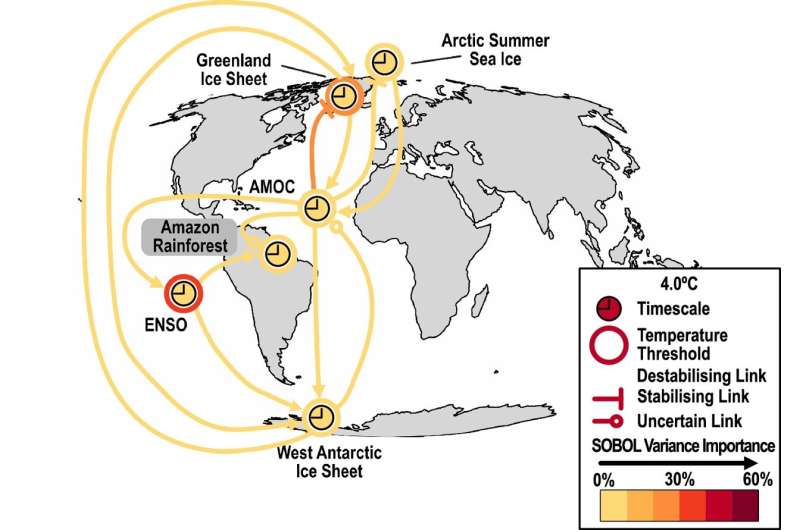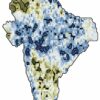Polar ice sheets are critical for climate projections, according to new research published Nov. 27 in the journal Nature Communications Earth & Environment. Improving understanding of the Greenland and Antarctic ice sheets is essential for reducing the uncertainty around climate tipping points, and vital for guiding projections for a rapidly changing future climate.
The polar ice sheets are the key to climate tipping points—thresholds in Earth’s systems that, when breached, lead to large and often irreversible environmental change. They have some of the lowest temperature thresholds, beyond which their condition would rapidly change, and they also have strong links to other climate tipping points. Despite this, their behavior is not well understood, and more progress is needed in modeling and observation.
Polar ice sheets are masses of ice exceeding 50,000 km2 that cover land at the poles, formed over long periods of time through layers of snow accumulating and transforming into glacial ice. Together, the Greenland and Antarctic Ice sheets hold more than 99% of Earth’s land ice.
Using a conceptual climate tipping model, scientists investigated how key components in our climate system interact and would be impacted by global warming at two levels, 1.5°C and 4.0°C. They found polar ice sheets to be responsible for substantial amounts of uncertainty in climate tipping projections.
Lead author, Jonathan Rosser, a researcher at the British Antarctic Survey says, “Climate tipping points represent a critical risk for human society over the next century—and a growing body of evidence demonstrates how much we have left to understand about these highly impactful risks. This study helps to focus our research onto the areas with the greatest contributions to our uncertainty about the future.”
The reality of tipping points
Environmental thresholds in the natural world have potentially huge impacts on human society if breached, and some are already at risk of being crossed. These tipping points include the polar ice sheets, the Amazon Rainforest, and ocean circulation systems, which act to regulate our weather and climate. Despite the importance of these systems, there is much uncertainty about how much warming is required to tip them, and how long this might take.

Sobol variance analysis at 4.0°C. © Communications Earth & Environment (2024). DOI: 10.1038/s43247-024-01799-5
This research shows that the behavior of the Greenland and West Antarctic ice sheets is one of the most important factors in understanding how these tipping points will act.
The polar ice sheets are potentially able to be tipped at current levels of global warming, which may lead to cascades of tipping throughout other systems such as ocean circulation. Therefore, reducing uncertainty in the behavior of the polar ice sheets through modeling, observations, and theoretical understanding is critical.
Assessing the interactions of climate components
Scientists assessed the impact of key components of the Earth’s climate system on climate tipping risks, using an established and simplified model for climate tipping elements.
The components they investigated were Arctic Sea Ice, El Niño Southern Oscillation (a climate pattern that involves temperature changes in the central and eastern tropical Pacific Ocean), the Greenland and West Antarctic Ice Sheets, the Atlantic Meridional Overturning Circulation (the conveyor belt-like system of ocean currents in the Atlantic Ocean), and the Amazon rainforest.
Scientists used the model to understand which of these components are the most important for reducing uncertainty in projecting future climate.
In a climate simulation at 1.5°C above pre-industrial temperatures, most of the change in climate was driven by the changes in the polar ice sheets, and in the 4.0°C scenario many tipping points were found to be crossed.
According to the IPCC AR6 Synthesis Report 2023, global warming is “more likely than not” to reach 1.5°C in the near future. Considering the high uncertainty in climate prediction methods, this research demonstrates that decision-makers should take a precautionary approach to the risk of triggering tipping points when planning for the future.
More information:
Jonathan P. Rosser et al, Polar ice sheets are decisive contributors to uncertainty in climate tipping projections, Communications Earth & Environment (2024). DOI: 10.1038/s43247-024-01799-5
Provided by
British Antarctic Survey
Citation:
Conceptual model illuminates role of polar ice sheets in climate tipping points (2024, November 29)



